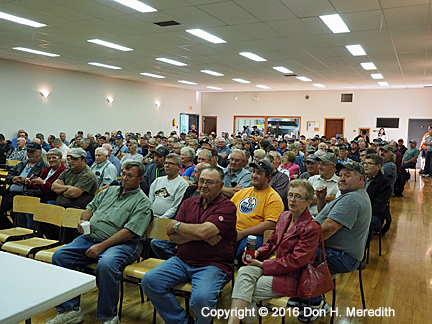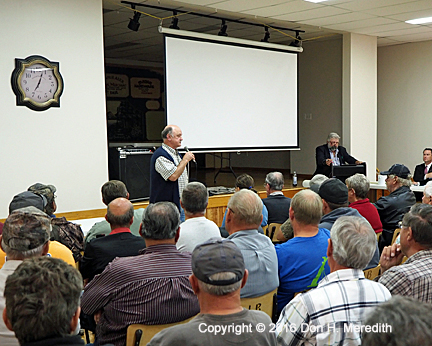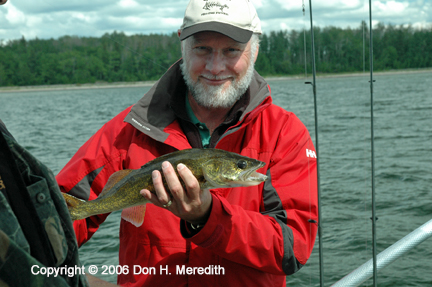[Note: The following was first published in the November 2016 Alberta Outdoorsmen.]
Copyright © 2016 Don H. Meredith, All Rights Reserved.
On arriving at the rural community hall, I saw the parking lot overflowing with pickups, cars and recreational vehicles. As expected, the hall was jammed with over 300 people seeking seats or just standing along the walls waiting for the proceedings to begin. Was this a wedding, funeral or dance? No, it was a meeting of anglers and other citizens concerned about the “Underutilized Fish Stocks in Northeast Alberta.” And the anger and frustration in the room was palpable.

Anglers came from far and wide to voice their concerns about the state of our fisheries.
If you have fished many lakes across Alberta in the last couple of decades, you’ve found most are extremely limited with regard to the number of walleye you can legally “take home for the frying pan.” Some lakes have zero catch-and-keep limits; others allow a limited number of fish to be caught and kept through a special licence draw system. Government fisheries biologists told us the walleye populations in these lakes had either collapsed or were near collapse and the restrictions were necessary to allow the populations to grow and produce a harvestable surplus again. So, we waited, believing the populations would come back within a few years. Five years turned into ten, 10 to 20, with no significant changes to the restrictions.
In the meantime, anglers have noticed the numbers of walleye they’ve caught and released have increased in many of these lakes. As well, they’ve noticed the pike in the lakes are thinner, and the populations of other species such as white fish, yellow perch and forage fish have seemingly declined. In other words, there appears to be a harvestable surplus of walleye in these lakes, and a more liberal walleye harvest regime might be warranted if just to improve the overall health of all the fish species in the lakes. So, why hasn’t the government allowed more fish to be taken from these lakes?
That was the question the people wanted answered at the meeting held on September 7th at the Lac Bellevue Community Hall south of St. Paul. Unlike other public meetings about fisheries or wildlife management I’ve attended, the government did not organize this one. Ray Makowecki, a veteran fisheries biologist and Fish Chair for Zone 5 of the Alberta Fish and Game Association, organized the meeting. Ray Danyluk, a former Progressive Conservative Member of the Alberta Legislative Assembly (MLA) for Lac La Biche-St. Paul, moderated the meeting. Although there were current politicians in the room (three Wildrose MLAs, four municipal mayors and reeves), they only spoke briefly at the end of the meeting. Also in the room were David Park, Alberta Environment and Parks (AEP) Section Head of Fisheries Management Policy, and Jordan Walker, Resource Manager for AEP’s Lower Athabasca Region. However, neither spoke by previous agreement. This meeting was for the anglers to express their concerns, and Park and Walker were there to listen.

Ray Makowecki described how fish stocks are assessed and what might be the problems.
Makowecki started the meeting with a presentation on how fish stocks are assessed in the province and what he perceived might be the problem with current fisheries management policy in Alberta. The meeting was then opened to anyone in the room who wanted to speak about what they were seeing on the lakes they fished and possible solutions. A wide variety of anglers supported the contention that walleye needed to be harvested in many of the lakes in the northeast. Many expressed their frustration with the Alberta government’s lack of response to their concerns. Danyluk kept the meeting on track and ensured each speaker’s main points were recorded correctly.
FWIN
Makowecki spent much of his presentation on the Fall Walleye Index Netting (FWIN) program that AEP uses to determine the walleye status in a lake. Biologists set gill nets of varying mesh sizes in the lake for 24 hours. The nets are pulled and the fish caught are counted and measured, assessing fish abundance, size and age-class distribution, sex ratio, growth and overall health.
One of the key factors used to determine whether a walleye population can sustain a consumptive fishery is the Catch per Unit Effort (CUE). It is determined from the number of walleye caught in 100 square metres of net in 24 hours. According to Makowecki, the AEP considers a CUE greater than 30 to be a stable lake, and a CUE of less than 15 to be collapsed. He believes AEP uses a “precautionary fisheries management style” and that these numbers are too high. He said CUEs of greater than 30 rarely exist and that CUEs of less than 30 exist for many lakes where walleye appear to be abundant.
In an e-mail exchange I had with AEP fisheries managers Park and Walker, they confirmed a precautionary principle is used, stating “One of the guiding principles of the Alberta Fish Conservation and Management Strategy is ‘The precautionary management principle will be applied to the conservation and management of wild fish.’ This means where we have insufficient factual information, we will make management recommendations erring on the side of caution.”
With regard to CUE thresholds being too high, Park and Walker wrote, “Catch-rates, or more properly population density, are only one of a suite of metrics used to determine the sustainability of a walleye population. When considered with the other metrics, FWIN catch-rate thresholds are not higher than necessary.”
Walleye Abundance

How long has it been since you’ve been able to catch-and-keep a walleye without a special licence?
Concerning the observed abundance of walleye in lakes, Park and Walker expected anglers would begin to see catch rates improve as walleye populations recovered. However, they did not expect to hear that improved walleye densities were affecting the health of the fishery. They point out that walleye in remote un-fished lakes do just fine, with the other species in the lakes not at risk. Sure, they have seen some changes to lakes when walleye recover, such as spottail shiners declining and whitefish moving to deeper water. But “those should be considered normal responses to the recovery of the top predator in a lake.”
Keeping a Fish
One suggestion that received unanimous support at the meeting was allowing each angler to catch-and-keep one walleye per season at some of the lakes. Park and Walker stated this was possible “but for many lakes the sustainable harvest would be reached in a matter of days for small lakes (<1000 ha) or weeks for large lakes.” They went on to describe a trial in 2003 at Vincent and Long Lakes where the walleye populations had recovered after years of catch-and-release fishing. Anglers were allowed one walleye, any size. They took the annual allowable harvest of walleye in 2.1 days at Vincent Lake and 3.4 days at Long Lake. “In simple terms, most recovered walleye lakes can sustain a harvest of, at most, 1 walleye per hectare. Angler effort is usually 3 to 10 anglers per hectare.”
Makowecki believes there are too few biologists to gather the data necessary to set proper regulations for each lake. Unless lakes are adequately assessed, zero catch-and-keep limits could remain indefinitely on some of these lakes even though some have actually recovered.
So, are there underutilized walleye populations? That answer depends upon whom you believe. What is obvious to me is that the government biologists have failed to communicate adequately with the people who use the resource. As a result, many anglers no longer believe the biologists. That doesn’t bode well for the future of fishing in this province. Without trust and respect between anglers and biologists, little progress will be made to improve conditions.
Next Steps
The proceedings of the meeting were recorded and attendees filled out surveys to capture all concerns and potential solutions. Makowecki says the information will be summarized and the best solutions will be advanced to the AEP minister with the aid of local MLAs. He is hoping “the people will be able to catch and keep a walleye in all these lakes by April 1, 2017.”
Comments are always welcome (below).
Visit me on my website where you’ll find more stories and pics:
www.donmeredith.ca
Interested in reading an award-winning outdoor adventure novel? Check out The Search for Grizzly One and Dog Runner.

Pingback: Shifting Away from Consumptive Use | Don Meredith Outdoors